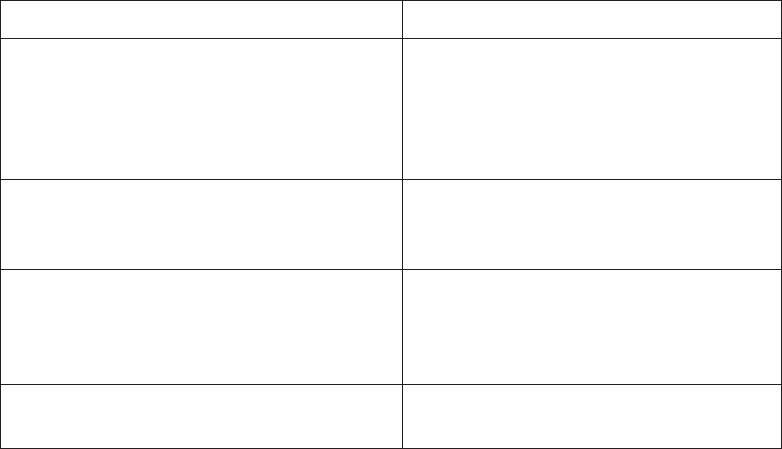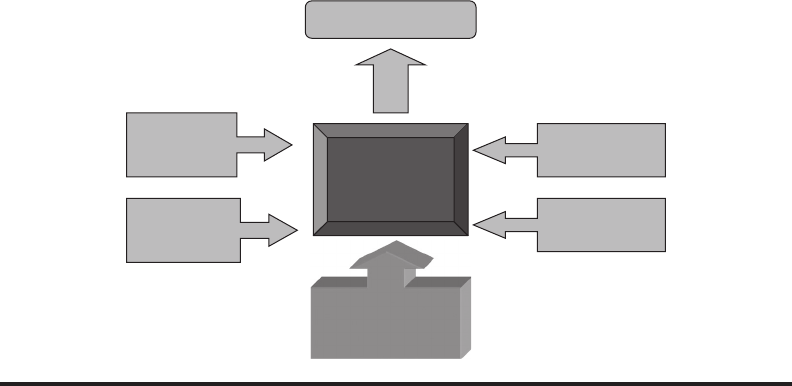
Intellectual Property ◾ 213
These pre-ling disclosures, although protected in the U.S., may preclude
patenting in foreign countries.
Unlike a non-provisional patent, the provisional patent is led without
any formal patent claims, oath, declaration, information disclosure, or prior
art statement. The written description of the invention and any drawings
necessary to more fully understand the invention must be provided for in an
application for a provisional patent.
If either of these two items is missing or incomplete, your application will
be rejected and no ling date will be given for your provisional application.
10.4.2 Advantages and Disadvantages
There are several advantages and disadvantages to provisional patents—the
reader is well advised to seek competent patent counsel. A well-written
provisional patent application should satisfy all formal and substantive legal
requirements of the patent law. A provisional patent application should
always be as complete as possible as compared to a non-provisional patent
application; however, you will not be required to le any claims. You can
conveniently use that grace year to collect additional data that may form a
basis for eventual claims.
The entrepreneur/inventor must carefully balance the plusses and
minuses of provisional patents, as shown in Table10.4.
Table10.4 Advantages/Disadvantages of provisional patents
Advantages Disadvantages
Relatively simple and inexpensive.
The specications will not be examined.
More comprehensive disclosures can be
followed at later time.
A provisional application automatically
becomes abandoned when its
pendency expires 12 months after the
provisional application ling date by
operation of law.
Can claim priority to multiple provisional
applications, as measured from the
earliest led application.
Provisional applications will not
mature into a granted patent without
further submissions by the inventor.
Once docketed, the term “Patent
Pending” can be used for business
purposes.
If not followed by a utility ling within
one year, the inventor must cease
using Patent Pending to avoid charges
of false marking.
The effective patent term is 21 years from
ling date of the provisional application.
Examination is delayed up to one year.
214 ◾ The Guide to Entrepreneurship: How to Create Wealth for Your Company
10.4.3 Patents Can Have Siblings/Children
Additional applications by the same inventor can be divided into three parts:
◾ Divisional
◾ Continuation
◾ Continuation-in-part
A divisional application is a type of patent application that contains
matter from a previously led application (the so-called parent applica-
tion). While a divisional application is led later than the parent appli-
cation, it may retain its parent’s ling date, and will generally claim the
same priority.
5
A continuation application is a second (or subsequent)
application directed to the same invention claimed in a prior co-pending
application of the same inventor. A continuation-in-part is an appli-
cation led during the pendency of an earlier application of the same
inventor, the latter application containing at least a substantial part of the
disclosure of the earlier application together with an additional matter not
so disclosed.
10.4.4 International Patent Organizations
The entrepreneur/inventor has three options when applying for a patent:
1. United States Patent Ofce (UPTO)
2. Patent Cooperation Treaty (PCT)—The PCT is an international agree-
ment for ling patent applications having effect in up to 117 countries.
6
Although the PCT system does not provide for the grant of an interna-
tional patent, the system:
− simplies the process of ling patent applications
− delays the expenses associated with applying for patent protection in
other countries and allows the inventor more time to assess the com-
mercial viability of the invention
3. European Patent Ofce (EPO)—The EPO grants European patents for
the Contracting States to the European Patent Convention. The EPO
provides a single patent grant procedure, but not a single patent from
the point of view of enforcement. EPO includes:
− Major European countries
− File in English, French, or German

Intellectual Property ◾ 215
10.5 Basis for Venture Investment
One of the major goals faced by seed and startup enterprises is access to
initial or subsequent rounds of nancing through either equity or debt.
Investors are crucially interested where an innovation ts in the marketplace
with reference to existing or potential competitors. Venture investors want
to know if the innovation promises a sustained advantage; and a patentable
innovation or invention offers compelling evidence to warrant a risky invest-
ment in the business, leading to eventual commercialization of the product.
7
This is shown in Figure10.4.
Venture investors need to maximize returns and minimize risks. As
shown in Figure10.4, venture risks can be classied into four categories: (1)
market, (2) nancial, (3) management, and (4) technological.
8
10.6 The America Invents Act
The Leahy–Smith America Invents Act (AIA) is a U.S. federal statute that
was passed by Congress and was signed into law by President Obama on
September 16, 2011. Named for its lead sponsors, Sen. Patrick Leahy (D-VT)
and Rep. Lamar Smith (R-TX), the Act switches the U.S. patent system from a
“rst to invent” to a “rst inventor to le” system, eliminates interference
Intellectual
Property
Rights
Seed/Startup IPR and Investments
Commercialization
Economic
rights
R&D
Trade secrets
Sustained
advantage
Investors
(equity/debt)
Innovations
Inventions
Figure 10.4 Seed/startup IPR—Investors are crucially interested if your innovation is
patentable.
216 ◾ The Guide to Entrepreneurship: How to Create Wealth for Your Company
proceedings, and develops post-grant opposition. Its central provisions went
into effect on March 16, 2013.
9
The most sweeping changes to the U.S. patent system in over 50 years
took effect on March 16, 2013, with the full enactment of the provisions of
the America Invents patent reform act. Among other key changes in the
current law, the act states that the rst person to le a U.S. patent applica-
tion will now be awarded the patent right, rather than the rst to invent.
Moreover, there will no longer be a grace period to le a U.S. application
after any public disclosure or sale of an inventive product. It is important for
all innovators, inventors, entrepreneurs, and business owners to be aware of,
and to understand, the potential impact that America Invents will have on
your intellectual property rights and business planning.
10.6.1 First to File
The biggest change is that the inventor who is rst to le a patent applica-
tion on an invention in the U.S. Patent Ofce now receives the patent right.
Before AIA, an inventor could carefully document his or her discovery,
conduct important technical and market research and, within reason, casu-
ally proceed with a patent ling when the product was ready and, more
importantly, funds were available from investors and others to proceed with
the costly act of patenting a product. As long as the inventor could prove he
or she invented rst, even an earlier patent led by mighty GM or Microsoft
would lose to our diligent inventor.
Now, if your competitor is working on the same concept and has a faster
R&D team or, better yet, a well-funded IP legal staff, then they will likely
beat you to the Patent Ofce and win the right to put you out of business in
the very product you worked so hard and long to develop. The old “race to
the Patent Ofce” is back with a vengeance. Ever heard of Elisha Gray? Most
probably, you have not. Elisha Grey was the telephone inventor who lost the
race to Alexander Graham Bell, even though most commentators agree he
invented the telephone rst.
10.6.2 No Grace Period
Another critical change after March 16, 2013 is the loss of the 1-year grace
period. This allowed the inventor’s product to be sold, used, or displayed
Intellectual Property ◾ 217
in public for up to 1 year before the inventor actually needed to le a patent
on it. You must now le a provisional patent application before publishing
your results, should you wish to protect your patent rights.
Now all that sympathetic forgiveness in the U.S. patent system will be
gone. If you publicly show/use a product or offer to sell it after March 16,
2013, then you will not be able to claim a patent on it unless your patent
application was led beforehand. There is a small exception for publications
by the inventor, but it is best to consult your patent attorney before trying to
use it.
Previously an inventor or startup could still obtain a patent after the
product was already shown or on sale for a few months. This is now impos-
sible. William Loginov, Esq.,
10
a patent attorney, developed a quick list of key
points to help you survive this savage jungle of U.S. patent reform:
◾ Did you perform a patent search of your concept? This can streamline
the ling process and avoid surprises later, especially if the patent is
challenged by a competitor in “post-grant” proceedings.
◾ Did you consult a patent attorney early in the process? A patent can
be led as long as the basic concepts are workable. Waiting for actual
“reduction to practice” is no longer a good idea in the race to le.
◾ Did you consider a provisional ling? Make sure it is well drafted as there
is no grace period to fall back on if the provisional is ruled defective.
◾ Did you make sure to avoid any offers for sale, public displays, publica-
tions, or public use of the concept before consulting your patent attor-
ney or ling a patent application? Otherwise, you may be kissing your
rights goodbye.
◾ Did you get a non-disclosure agreement (NDA) for any needed discus-
sions with third parties like vendors, suppliers, beta-testers, manufac-
turers, etc? An NDA makes these activities nonpublic, avoiding AIA.
Remember, these third parties cannot do anything public with the
concept; for example, any beta testing must be strictly internal and not
for the purpose of serving paying customers.
◾ Are all your inventors and key employees under an NDA or simi-
lar agreement? Anyone with access to the concept should be under
secrecy.
◾ As the project progresses, are you contacting the patent attorney at key
development stages to update the patent coverage if needed? Remember
this is now a race!
..................Content has been hidden....................
You can't read the all page of ebook, please click here login for view all page.
